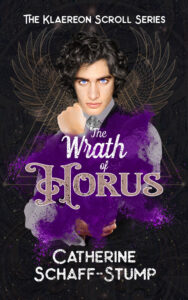Guest Post: Catherine Schaff-Stump on Dante’s Inferno or The Devil’s Fan Fiction
 Dante’s Inferno or The Devil’s Fan Fiction
Dante’s Inferno or The Devil’s Fan Fiction
By Catherine Schaff-Stump
On October 31st, an auspicious date to talk about the devil, I will be releasing the third book in my Klaereon Scroll Series, The Wrath of Horus. This book is a great place to jump into the series, because it is a book about the second generation of the family. It’s good to know the background from the first two books, but you can read this book without it. In case you’re wondering from the title, I am sending my characters to Dante’s Inferno.
It’s an easy thing to do. The Klaereons are demon binders, hooked up with ancient Egyptian gods banished to an Abyss by the sorcerer King Solomon, in that king’s attempt to teach them humility. Through a series of unfortunate events, our characters end up in the Abyss on the eve of Gregorius Klaereon’s Trial against the god Horus. The Hell they end up in is patterned after Dante’s.
There are lots of issues in the novel about why the characters end up in this version of the Inferno, and if this is the only version of Hell that there is. These are philosophical questions that will follow these poor souls into their next book. What I want to do in this article is talk a little bit about The Divine Comedy itself, focusing on Inferno, and talk a little bit about what Dante was doing when he wrote it.
Who was Dante Alighieri? Dante was born around 1265 in Florence and died we think in 1321 at age 56. He was a poet, a writer, and a philosopher, and some will tell you the current Italian language is based on the language he used to write Italy’s most famous poem. His vision of the divine afterlife fueled the church’s vision of the afterlife ever after.
To understand The Inferno, we must understand the unique blend of political commentary, theological thought, classical poetry, and biography Dante used to compose it. Dante was a political exile from Florence caught in papal machinations of the time. He was ordered to pay a fine to return to Florence, but instead stood by his innocence. His exile fed the political commentary in the poem. It’s interesting to read the poem and come across many of the biggest sinners who are people who have wronged Dante in his past. Dante’s most obscure references in the poem are personal, and only extensive scholarly footnotes will get you through these encounters.
That said, Dante draws heavily on classical poetry to shape what he feels the poem must be. Dante’s guide through The Inferno and the first part of Purgatorio is the poet Virgil, who is a fictionalized version of the Roman poet Vergil, as if no one would notice. Virgil is a pagan guide who has no chance of entering Christian heaven. Virgil and Dante encounter many twisted mythological versions of creatures and legends, such as King Midas, who herein has a tail which thrusts souls down to their judgment level of Hell, and more familiar underworld characters such as Charon and Cerebus. Dante also infuses his poem with a platonic love for the character Beatrice, who sends Virgil to Dante to get Dante up to heaven, and help Dante understand he must change his ways before he dies to avoid damnation.
Dante draws heavily upon the theology of the time. There is a level outside of the circles of punishment for virtuous pagans. As we progress through each level of the Inferno, the sins become more and more serious. The outer levels are sins we commit against ourselves, such as sins of lust, gluttony, avarice, sloth, and wrath. We then enter the city of Dis and we go into deeper sins, such as violence against as others, self, and God, the lands of murderers, suicides, and those who participate in what Dante’s contemporaries thought of as unspeakable acts. Interestingly, I found Dante not as anti-gay as I thought he would be. In many cases acting upon the deed is more important than the desire for it. Then we have levels of flatterers and corrupt churchmen, which is considered a far worse sin than violence. Finally, the ultimate sins of betrayal finish the Inferno, with the only way out being through Lucifer’s body himself.
The medieval mind is very different, or perhaps it is Dante himself. People are often punished for acting on desires that are against parsimony and prudence. Churchmen are punished severely for selling false penance and acting in ungodly ways. Yet, it seems that someone who is gay or someone who wants to kill themselves would be something we would consider very differently in our contemporary world.
Dante’s Divine Comedy’s most famous and favorite part is The Inferno, which tells us something about our fascination with sin and human suffering. Purgatorio is interesting because it shows the ways in which souls can be remade for Heaven. Paradiso is highly theological, if not as interesting.
If you’d like to follow Gregorius and Marcellus Klaereon and their friends and family through the Abyss, you can pre-order the book here: http://www.amazon.com/Wrath-Horus-Klaereon-Scroll-Book-ebook/dp/B091DGQXW6/ref=sr_1_1?dchild=1&keywords=The+Wrath+of+Horus&qid=1630540938&sr=8-1
The paperback will be available around that time as well. For more information on my writing, you can visit http://cathschaffstump.com
***
Cath Schaff-Stump writes fantasy for children and adults. She writes funny stories, dark stories, and everything in between. She is the author of the Klaereon Scroll series and the Abigail Rath Versus series. Cath lives and works in Iowa. During the day, she teaches English at a local community college. More of her fiction has been published by Paper Golem Press, Daydreams Dandelion Press, and in The Mammoth Book of Dieselpunk. You can find her online at Facebook, Goodreads, Amazon, @cathschaffstump, and cathschaffstump.com. Follow Cath’s Kindle Vella serial The Autumn Warrior and the Ice Sword.

Comments